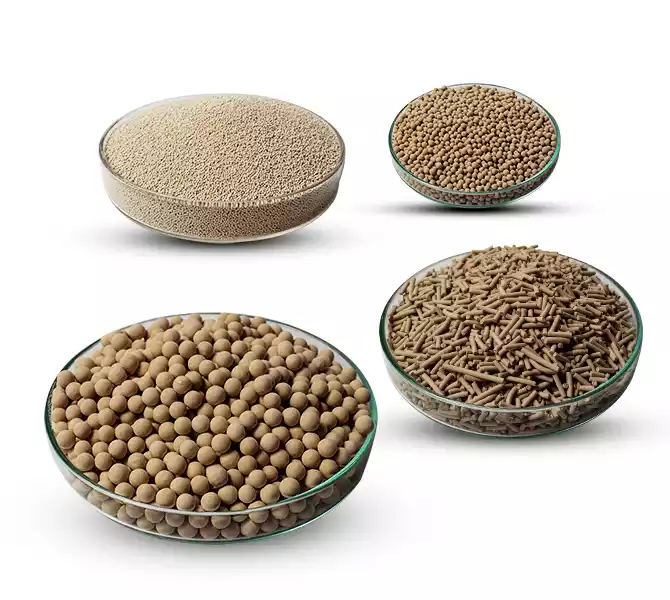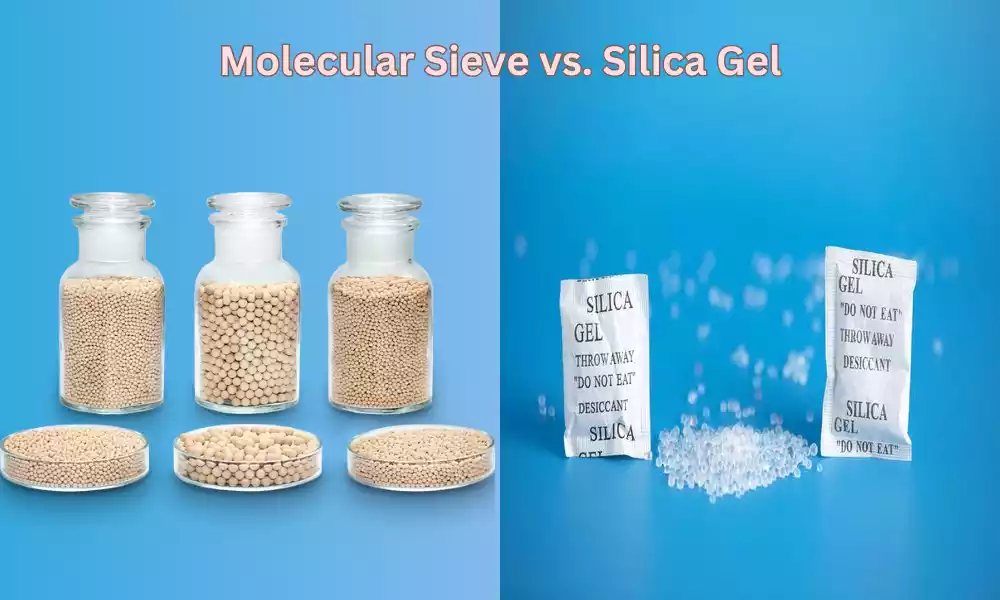In the healthcare industry, maintaining the quality and shelf life of products is of utmost importance. Medications and healthcare products must remain effective and free from degradation, whether they are on store shelves or dispensed by pharmacies.
To safeguard pharmaceuticals, supplements, vitamins, and diagnostic items like pregnancy tests, many companies incorporate desiccants to regulate moisture and ensure the long-term effectiveness of their products. Among the various desiccant options available, two stand out as the most commonly employed in the healthcare sector: Molecular sieve and silica gel.
What is a Molecular Sieve?
A molecular sieve is a desiccant made from aluminosilicate materials. It has a unique three-dimensional structure with tiny pores. Molecular sieves are employed to selectively adsorb and trap water molecules from the surrounding environment, effectively reducing humidity.

They are known for their rapid and efficient drying capabilities, making them ideal for applications where quick moisture removal is necessary. Molecular sieves are particularly useful in scenarios requiring low humidity levels and can maintain their effectiveness even at elevated temperatures. Common applications include pharmaceuticals, electronics, and any environment where low humidity is crucial.
What is Silica Gel?
Silica gel is a desiccant made from processed silica, a naturally occurring mineral. It is known for its moisture-absorbing properties and is often used to control humidity and prevent moisture-related damage in various applications. Silica gel comes in different forms, such as granules or beads, and it functions like a sponge, drawing moisture into its numerous pores.
One of its notable features is the ability to absorb a significant amount of water, up to 40% of its weight. Silica gel is commonly used in pharmaceuticals, food packaging, electronics, and many other situations where moisture control is essential.

Comparison Table: Molecular Sieve vs. Silica Gel
Molecular Sieve is a rapid and efficient desiccant composed of aluminosilicate, perfect for low humidity environments and stable at high temperatures. It selectively adsorbs moisture with its 3D structure. Silica Gel, made from processed silica, is FDA-approved for food and drug packaging. It has moisture-absorbing qualities but is not as quick as a Molecular Sieve, and may not withstand high temperatures well. Silica Gel is widely used in various applications, including pharmaceuticals and general moisture control. Here is the difference between Molecular Sieve and Silica Gel.
| Property / Aspect | Molecular Sieve | Silica Gel |
|---|---|---|
| Moisture Absorption Rate | Excellent | Good |
| Functionality in High Temperatures | Excellent | Fair |
| Capacity at Low Relative Humidity | Excellent | Poor |
| Composition | Aluminosilicate | Silica-based |
| Structure | 3D framework | Porous granules |
| FDA Approval | Yes | Yes (for food and drug packaging) |
| Ideal for Low Humidity | Yes | No |
| Stability at Elevated Temperatures | Yes | No |
| Common Applications | Pharmaceuticals, electronics, low humidity environments | Pharmaceuticals, food packaging, and general moisture control |
| Physical Forms Available | Beads, pellets, powder | Beads, granules, and powder |
How to Choose Between Molecular Sieve and Silica Gel
While the aforementioned information outlines the differences between molecular sieve and silica gel, various factors should be taken into account when selecting a desiccant for your product.
Before making a decision, consider these additional factors:
- Relative humidity
- Temperature range
- Moisture fluctuations
- Pressure changes
- Mechanical forces
- Assembly options
Incorporating a Desiccant into Your Product:
Both molecular sieve and silica gel can be seamlessly integrated into a product. Desiccants are available in various forms, from packets and canisters to adhesives and other formats, offering solutions for every application.
If you require further assistance in choosing between a molecular sieve and silica gel, do not hesitate to contact Multisorb for expert desiccant advice. Your product’s quality and longevity are in good hands.
What is a molecular sieve used for?
Molecular sieves are used primarily for moisture control in various applications. They are particularly valuable in:
- Pharmaceuticals: Ensuring the stability and quality of drugs and medications.
- Electronics: Preventing moisture damage to sensitive electronic components.
- Industrial Processes: Removing water from gases and liquids.
- Natural Gas and Petrochemical Industry: Drying and purifying gases and liquids.
- Air Separation: Separating gases, like nitrogen and oxygen, from air.
Their ability to maintain low humidity levels and stability at high temperatures makes molecular sieves indispensable in these industries.
What are the advantages of Molecular Sieve and Silica Gel sieves?
Molecular Sieve Advantages:
- Fast Moisture Absorption: Molecular sieves have a rapid adsorption rate, making them effective at quickly removing moisture from the environment.
- High Selectivity: They can selectively adsorb water molecules while leaving other gases untouched, allowing for precise moisture control.
- Stability at High Temperatures: Molecular sieves remain effective even in elevated temperature conditions, making them suitable for various applications.
- Ideal for Low Humidity Environments: They are excellent for maintaining low humidity levels, crucial in certain industries.
Silica Gel Advantages:
- FDA-Approved: Silica gel is approved by the FDA for use in food and drug packaging, ensuring safety for these applications.
- Moisture Absorption Capacity: It can absorb a significant amount of moisture, up to 40% of its weight, making it effective in many moisture control scenarios.
- Versatility: Silica gel is widely used in a range of applications, including pharmaceuticals, food packaging, and general moisture control.
- Ease of Use: It is available in various forms (granules, beads, powder) and can be easily integrated into products.
What are the disadvantages of Molecular Sieve and Silica Gel sieves?
Disadvantages of Molecular Sieve:
- Cost: Molecular sieve desiccants can be more expensive compared to silica gel and other desiccants.
- Not as Versatile: While highly effective in low humidity and high-temperature applications, they may not be as universally applicable as silica gel.
Disadvantages of Silica Gel:
- Slower Moisture Absorption: Silica gel has a slower adsorption rate compared to molecular sieves, which may not be suitable for applications requiring rapid moisture control.
- Limited Temperature Tolerance: It may not be as stable at high temperatures as molecular sieves, limiting its use in high-temperature environments.
- May Not Be Ideal for Low Humidity: Silica gel is not as efficient as molecular sieves in maintaining extremely low humidity levels.
Conclusion of Molecular Sieve and Silica Gel
Molecular Sieve and Silica Gel are both essential desiccants with distinct advantages and disadvantages. Molecular sieve excels in fast moisture absorption, high-temperature stability, and low-humidity environments, making it ideal for specialized applications.
Silica gel, on the other hand, is versatile, FDA-approved, and effective in a wide range of scenarios but has slower moisture absorption and limited temperature tolerance. The choice between them depends on specific application requirements, with each desiccant offering valuable solutions for moisture control in various industries.
Frequently Asked Questions (FAQs):
1. Which desiccant should I choose for pharmaceutical products with strict moisture control requirements?
- A molecular sieve is an excellent choice for pharmaceuticals with stringent moisture control needs, particularly when low humidity and stability under high temperatures are essential.
2. Can I use Silica Gel in electronic packaging to protect against moisture damage?
- Yes, Silica Gel is commonly used in electronic packaging to prevent moisture-related damage.
3. Are both Molecular Sieve and Silica Gel safe for direct contact with drugs and food items?
- Yes, both Molecular Sieve and Silica Gel are FDA-approved and considered safe for use in drug and food packaging.
4. Which desiccant is better for maintaining product quality during long-term storage?
- A molecular sieve is preferable for long-term storage, especially when products need to remain stable over extended periods.
5. Are there any environmental considerations when choosing between these desiccants?
- Both Molecular Sieve and Silica Gel are environmentally safe and can be disposed of without harm to the environment. However, it’s essential to follow proper disposal guidelines for desiccants.




